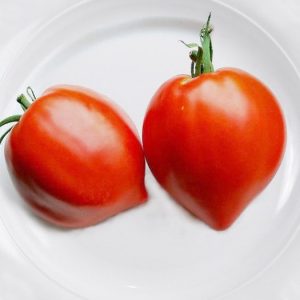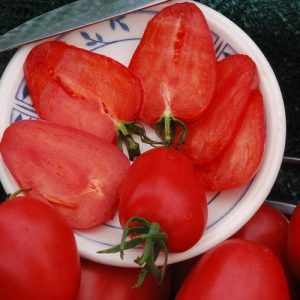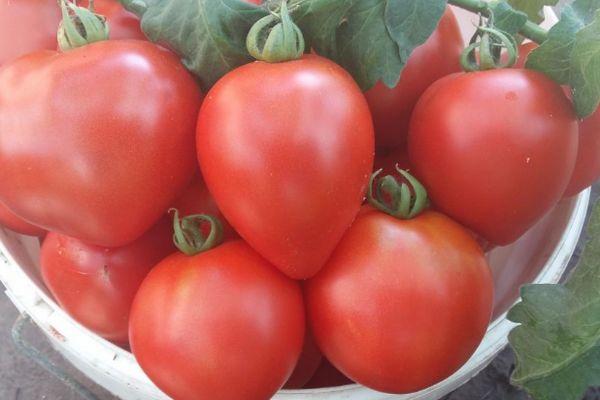Tomato variety "Strawberry tree" - Siberian disease resistance and high yield
Modern breeding never ceases to delight gardeners with new varieties of tomatoes. The seeds of plants with fruits of the most unusual shape and color come to the markets. Black, pink, yellow, green, purple and brown berries will surprise no one. Tomatoes look more exotic, the bushes of which resemble a tree.
These include the Strawberry Tree Tomato. The plant itself looks unusual and decorative. Its heart-shaped fruits resemble large strawberries. They are formed by brushes. Is such a tomato attractive only for its beautiful appearance - read on.
The content of the article
General Description of the Strawberry Tree
The strawberry tree is a tomato variety bred by domestic breeders. The Siberian agricultural company "Siberian Garden" is considered the originator. The variety entered the Sibiriada series.
The Strawberry tree was added to the State Register in 2013. Since then, the variety has gained popularity among gardeners around the world.
Note! Seeds taken from the fruits of the Strawberry tree ripe on the bush are used for planting. The planting material is collected together with the pericarp, after which it is washed, dried with a paper towel and stored in tissue bags.
The variety got its name because of the unusual shape of the fruits and bushes. The plant really looks like a tree covered with large strawberries.

Red tomatoes are high in lycopene. It is a strong antioxidant that the human body does not produce on its own.
Tomatoes help eliminate toxins, toxins and free radicals from the body, as well as cleanse the cardiovascular system. Contained in red berries and serotonin. It improves mood.
Main characteristics
The strawberry tree belongs to varietal tomatoes, but in terms of parameters it is in no way inferior to hybrids.
Characteristics and description of the variety of tomatoes Strawberry tree:
| Parameter | Indicators |
| Bush type | Indeterminate, medium-branched bush. It reaches a height of 2 m when grown in a greenhouse and 1.7 m when cultivated in an open field. The stems are strong and powerful. Covered with a lot of foliage. The leaf plate is large and smooth, of the usual tomato shape and dark green in color. The bushes have short internodes. Because of this, the brushes are located close to each other. 6 brushes are formed on one bush. The inflorescences are simple. Fruits are formed in clusters of 6-7 pcs. on each. |
| Growing method | The manufacturer recommends planting tomatoes in a greenhouse. The experience of gardeners shows that in the southern and central regions, plants do well in the open field. |
| Yield | High. Up to 5.5 kg of harvest is harvested from one bush. From 1 sq. m receive up to 17 kg of harvest. |
| Fruit | Large. The weight of one berry varies between 200-300 g. They have the shape of a heart, so they resemble a large strawberry. There is no pronounced ribbing at the base. The color of the tomatoes is deep red inside and out. There is no green spot at the base. The taste is sweet, with a noticeable sourness. Rich tomato aroma. There is a lot of tender and juicy pulp. The dry matter content reaches 12%. Each fruit has 2–4 seed chambers with a small number of seeds. Berries of this variety are considered salad. They are consumed mainly fresh. They are also suitable for cooking tomato products and freezing in pieces. They are not preserved entirely due to their large size. |
| Transportability | Average.The fruits tolerate transportation well, but they are stored at room temperature for no more than 3 weeks. |
| Ripening terms | Mid-season variety. The first berries ripen 110–115 days after the first shoots appear. |
| Disease resistance | Despite being a cultivar, the Strawberry tree is highly immune to most tomato diseases. In this it is not inferior to hybrids. |
Pros and cons of the variety
The strawberry tree has many virtues. It is thanks to them that he is so popular:
- decorative type of plant;
- beautiful and tasty fruits;
- high immunity to tomato diseases;
- high productivity;
- resistance to temperature extremes;
- the ability to use seeds from your own harvest for planting.
The disadvantages include the need for garter and pinching. Tomatoes also crack when there is a lack of watering.
Agricultural rules
The strawberry tree is recommended for greenhouse cultivation. In regions with a warm climate, it is successfully grown in the open field.
For mid-ripening tomatoes in our country, only the seedling method of growing is suitable. Otherwise, the tomatoes simply won't have time to ripen.
Seeds are sown for seedlings in March. The colder it is in the region, the later they start growing seedlings.
Plants are transplanted to a permanent place 55-60 days after sowing the seeds. If you do this later, there will be an increased risk that the seedlings will not take root after the pick or the yield will be low.
Growing seedlings
It is important to check the expiration dates of the seeds before purchasing. Expired planting material has a low germination rate.
Tomato seeds are pretreated. This prevents infection of plants, increases their endurance, accelerates germination:
- Checking the planting material for the ability to germinate. To do this, it is soaked in a glass of water with a spoonful of salt. After half an hour, the emerged specimens are collected and thrown away, and those that have sunk to the bottom are washed under running water and used for planting.
- Disinfection... The seeds are soaked for 30 minutes. in a solution of potassium permanganate, for 15 minutes. in hydrogen peroxide or for 12 hours in a solution of soda. Then washed under running water.
- Growth stimulation... Seeds are soaked in "Epin", "Sodium humate" or "Zircon". Instead of purchased preparations, some gardeners use a solution made from a teaspoon of honey and a glass of warm water.
Processed seeds are sown in large boxes or trays. The containers are also treated before sowing seeds, soaking for half an hour in a strong solution of potassium permanganate.
The soil for tomatoes should be light and nutritious. There are several options for soil mixtures:
- peat and sand in equal proportions;
- black soil, sawdust and humus in equal proportions;
- black soil and river sand in equal proportions.
The soil is also treated - watered with boiling water or a dark pink solution of potassium permanganate. Another option is to heat the ground in the oven.
Soil is poured into the container so that 2 free centimeters remain to the edge. Moisten with warm settled water. Seeds are spread in rows. There should be a distance of at least 2 cm between the specimens. The planting material is sprinkled with a centimeter layer of soil.
The containers with seeds are covered with foil and placed in a warm place. Before seed germination, the film is periodically opened and the soil is sprayed as it dries.
Within a week after the appearance of the first shoots, the shoots should be under the film. Every day it is opened for 1 hour for airing.
Then the tomatoes are rearranged in a cool room. They stay there for a week, after which they return to warmth.
The seedlings in the common box are carefully watered under the root from a pipette or syringe. It is important that the soil does not dry out, but also not too wet. Otherwise, immature plants will die.
After real leaves appear on the tomatoes, they are dived into separate containers.It is most convenient to use peat pots, which do not have to be removed when planting seedlings in a permanent place. Plastic containers, such as disposable cups, will work.
Advice... There must be holes in the bottom of the container for picking seedlings.
Broken dishes, fine gravel or shell rock are poured into the bottom of the pots. Drainage reduces the likelihood of blackleg infestation.
After the pick, the tomatoes are not watered or fed for 10 days. This time is necessary for plants to take root in a new place.
2 weeks after the pick, the first feeding is applied - vermicompost. With an interval of 2 weeks, fertilizers are applied 2 more times. For this, preparations containing phosphorus are used. This contributes to the formation of a strong root system.
2 weeks before planting in a permanent place, the tomatoes begin to harden. For the first time, the plants are taken out into the street in a warm season for 30 minutes. Then the time is doubled. So the duration of hardening is gradually brought to 12-16 hours.
Landing in the ground
For tomatoes, choose the sunniest place on the site, where other nightshade crops did not grow last year. The best precursors for tomatoes are legumes, melons and cabbage.
The beds are prepared in advance. To do this, in the fall, they are dug up to a depth of 20 cm and cleaned of plant residues. Humus is scattered over the soil at the rate of 5 kg per 1 sq. m. If the acidity of the soil is increased, it is reduced with dry lime. Then the soil is dug up again, mixing with fertilizers.
In the spring, the beds are leveled with a rake. In the process, weeds are removed.
The holes are dug in rows. For 1 sq. m place 3 plants. To save space, the indentations are staggered.
Pour 1 tbsp into each hole. l ash. A wooden support or plastic trellises are installed nearby.
After planting the plants in a permanent place, the soil around the stem is compacted. Water using 1 liter of water for each tomato.

Care and watering
Regular caring for tomatoes is the key to a good harvest. The list contains basic rules:
- Strawberry tree tie up as you grow. To attach the bush to the support, a synthetic thread is used that does not rot from moisture. If the hands are very heavy, they are also tied up.
- The plant is formed into two stems. To do this, leave one under the flower brush stepson... All other processes are removed. Leaves are also cut to the first flower cluster and yellowed greens. This procedure is carried out once a week, removing no more than 3 sheets per session.
- Watered tomatoes with water at room temperature as the soil dries: in the greenhouse - 1 time per week, in the open field - 2-3. Water should not fall on the ground part of the plants. Otherwise, burns will appear on the leaves.
- After every watering the soil is loosened to remove the earth crust... Weeds are removed in the process.
- Periodically tomato bushes shaketo speed up the formation of ovaries.
- Tomato beds mulch humus, straw or hay. Mulch protects against diseases, pests and negative environmental factors, slows down the growth of weeds and acts as an additional fertilizer.
- During the season, the Strawberry tree is fed 4 times, alternating mineral and organic fertilizing... The tomatoes are watered before fertilizing to prevent the roots from burning down the nutrients.
Prevention of diseases and pests

Tomato variety Strawberry tree is not afraid of diseases inherent in nightshades. However, the rules of prevention should still be followed:
- Seeds, containers for seedlings, soil, walls of the greenhouse are disinfected. A solution of potassium permanganate or copper sulfate is used as a disinfectant.
- The beds are cleared of weeds and plant residues, since infections persist on them.
- Watering should be rare and abundant. In conditions of high humidity, pathogens develop rapidly.
- Pathogens and insects are actively spreading around the greenhouse. To avoid damage to plants, the room is regularly ventilated.
- The bushes are sprayed with a decoction of celandine or wormwood. A solution prepared from a bar of soap rubbed into a bucket of water is also used.
Reviews of gardeners
Feedback from those who planted the Strawberry Tree is mostly positive. This variety has no significant disadvantages.
Anna, St. Petersburg: “I have been planting a strawberry tree for the third year. I grow in a greenhouse. This is my favorite red tomato variety! I shape it into two stems. The harvest is very rich, does not get sick at all, is not afraid of cold snaps. The berries are really heart-shaped. The taste is sweet, with a barely noticeable sourness, very fleshy. The bushes really look decorative like in the photo. "
Igor, Voronezh: “I grow a Strawberry tree outdoors. Form into two stems. The variety is unpretentious, but requires timely watering. When dry, the fruits do crack. I harvest the first crop at the end of July. Fruiting continues until autumn. The tomatoes are delicious and beautiful. They are good both fresh and for making tomato juice. "
Conclusion
Tomato Strawberry tree will fulfill the wildest dreams of the gardener. This is a high-yielding variety with a rich fruit flavor and many beneficial substances in its composition.
It is not difficult to grow such tomatoes. They are not afraid of diseases and temperature changes. Even novice gardeners can cope with their agricultural technology. By following the rules of cultivation, you can get a good harvest.